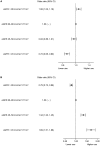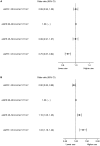Impact of chronic kidney disease on use of evidence-based therapy in stable coronary artery disease: a prospective analysis of 22,272 patients
- PMID: 25051258
- PMCID: PMC4106833
- DOI: 10.1371/journal.pone.0102335
Impact of chronic kidney disease on use of evidence-based therapy in stable coronary artery disease: a prospective analysis of 22,272 patients
Abstract
Purpose: To assess the frequency of chronic kidney disease (CKD), define the associated demographics, and evaluate its association with use of evidence-based drug therapy in a contemporary global study of patients with stable coronary artery disease.
Methods: 22,272 patients from the ProspeCtive observational LongitudinAl RegIstry oF patients with stable coronary arterY disease (CLARIFY) were included. Baseline estimated glomerular filtration rate (eGFR) was calculated (CKD-Epidemiology Collaboration formula) and patients categorised according to CKD stage: >89, 60-89, 45-59 and <45 mL/min/1.73 m2.
Results: Mean (SD) age was 63.9±10.4 years, 77.3% were male, 61.8% had a history of myocardial infarction, 71.9% hypertension, 30.4% diabetes and 75.4% dyslipidaemia. Chronic kidney disease (eGFR<60 mL/min/1.73 m2) was seen in 22.1% of the cohort (6.9% with eGFR<45 mL/min/1.73 m2); lower eGFR was associated with increasing age, female sex, cardiovascular risk factors, overt vascular disease, other comorbidities and higher systolic but lower diastolic blood pressure. High use of secondary prevention was seen across all CKD stages (overall 93.4% lipid-lowering drugs, 95.3% antiplatelets, 75.9% beta-blockers). The proportion of patients taking statins was lower in patients with CKD. Antiplatelet use was significantly lower in patients with CKD whereas oral anticoagulant use was higher. Angiotensin-converting enzyme inhibitor use was lower (52.0% overall) and inversely related to declining eGFR, whereas angiotensin-receptor blockers were more frequently prescribed in patients with reduced eGFR.
Conclusions: Chronic kidney disease is common in patients with stable coronary artery disease and is associated with comorbidities. Whilst use of individual evidence-based medications for secondary prevention was high across all CKD categories, there remains an opportunity to improve the proportion who take all three classes of preventive therapies. Angiotensin-converting enzyme inhibitors were used less frequently in lower eGRF categories. Surprisingly the reverse was seen for angiotensin-receptor blockers. Further evaluation is required to fully understand these associations. The CLARIFY (ProspeCtive observational LongitudinAl RegIstry oF patients with stable coronary arterY disease) Registry is registered in the ISRCTN registry of clinical trials with the number ISRCTN43070564. http://www.controlled-trials.com/ISRCTN43070564.
Conflict of interest statement
Figures



References
-
- Anavekar NS, McMurray JJ, Velazquez EJ, Solomon SD, Kober L, et al. (2004) Relation between renal dysfunction and cardiovascular outcomes after myocardial infarction. N Engl J Med 351: 1285–1295. - PubMed
-
- Tonelli M, Muntner P, Lloyd A, Manns BJ, Klarenbach S, et al. (2012) Risk of coronary events in people with chronic kidney disease compared with those with diabetes: a population-level cohort study. Lancet 380: 807–814. - PubMed
-
- Latif F, Kleiman NS, Cohen DJ, Pencina MJ, Yen CH, et al. (2009) In-hospital and 1-year outcomes among percutaneous coronary intervention patients with chronic kidney disease in the era of drug-eluting stents: a report from the EVENT (Evaluation of Drug Eluting Stents and Ischemic Events) registry. JACC Cardiovasc Interv 2: 37–45. - PubMed
-
- Roghi A, Savonitto S, Cavallini C, Arraiz G, Angoli L, et al. (2008) Impact of acute renal failure following percutaneous coronary intervention on long-term mortality. J Cardiovasc Med (Hagerstown) 9: 375–381. - PubMed
-
- Sarnak MJ, Levey AS, Schoolwerth AC, Coresh J, Culleton B, et al. (2003) Kidney disease as a risk factor for development of cardiovascular disease: a statement from the American Heart Association Councils on Kidney in Cardiovascular Disease, High Blood Pressure Research, Clinical Cardiology, and Epidemiology and Prevention. Circulation 108: 2154–2169. - PubMed
Publication types
MeSH terms
Substances
Associated data
LinkOut - more resources
Full Text Sources
Other Literature Sources
Medical
Research Materials
Miscellaneous

